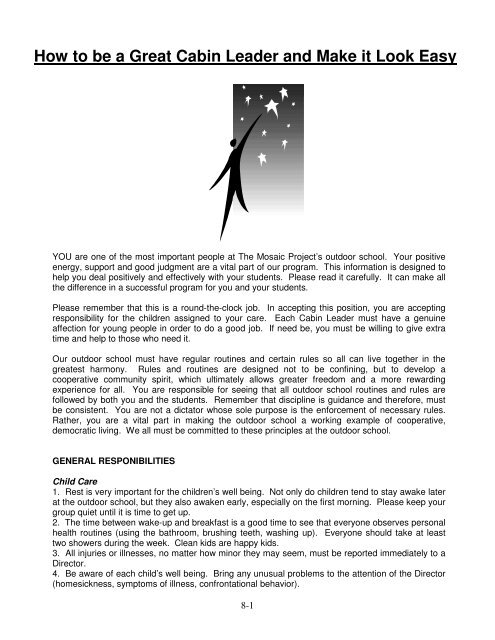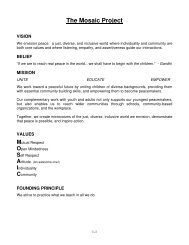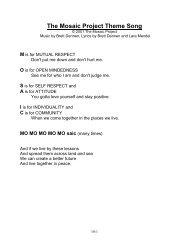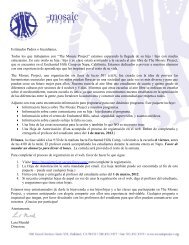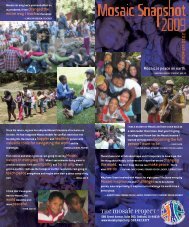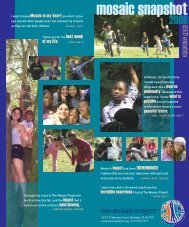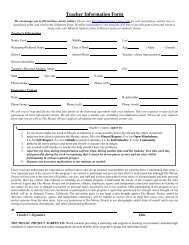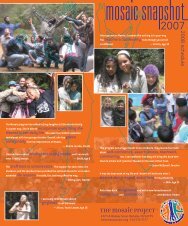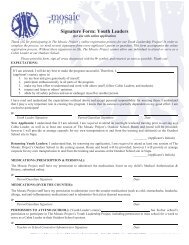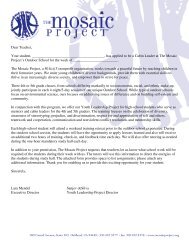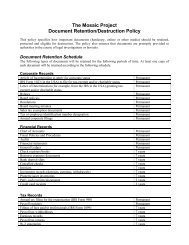How to be a Great Cabin Leader and Make it Look Easy
How to be a Great Cabin Leader and Make it Look Easy
How to be a Great Cabin Leader and Make it Look Easy
Create successful ePaper yourself
Turn your PDF publications into a flip-book with our unique Google optimized e-Paper software.
Meals1. Please <strong>be</strong> prompt for each meal. Think ahead <strong>and</strong> make sure your group is ready <strong>and</strong> on time.This is especially important if you are on KP <strong>and</strong> your cabin has <strong>to</strong> set up the dining hall <strong>be</strong>fore ameal.2. Meals should <strong>be</strong> a pleasant time <strong>to</strong> share daily experiences. Set a good example through yourmanners. You are the host at your table.Activ<strong>it</strong>ies1. Your enthusiasm <strong>and</strong> active participation is extremely important. Your example will encouragethe students <strong>to</strong> participate <strong>and</strong> increase their interest in learning. It is often tempting <strong>to</strong> join another<strong>Cabin</strong> <strong>Leader</strong> <strong>and</strong> pull apart from the group during an activ<strong>it</strong>y. Please stay focused on the kids <strong>and</strong>the activ<strong>it</strong>ies.2. Be aware of where each student is. If you start <strong>to</strong> fall <strong>be</strong>hind the group in wa<strong>it</strong>ing for a child,please let another staff mem<strong>be</strong>r know immediately.3. Encourage the use of restrooms <strong>be</strong>fore any activ<strong>it</strong>y, but especially <strong>be</strong>fore a hike. <strong>How</strong>ever, <strong>be</strong>supportive if a child needs <strong>to</strong> go later.4. You <strong>and</strong> the staff mem<strong>be</strong>r assigned <strong>to</strong> your cabin are considered a teaching team for cabingroup activ<strong>it</strong>ies. You will also <strong>be</strong> assigned <strong>to</strong> a sharing group, a mix-gendered group of about 16children which is unrelated <strong>to</strong> the cabin groups. You will <strong>be</strong> responsible for assisting the staff inimplementing the curriculum. You are encouraged <strong>to</strong> give input, challenge the students w<strong>it</strong>hquestions, <strong>and</strong> <strong>to</strong> otherwise aid all staff you work w<strong>it</strong>h during activ<strong>it</strong>ies. If you wish <strong>to</strong> lead anactiv<strong>it</strong>y, art project, or game for everyone, please discuss <strong>it</strong> w<strong>it</strong>h the Direc<strong>to</strong>r. Your input is greatlyappreciated!5. Learn <strong>to</strong> recognize <strong>and</strong> avoid poison oak! Encourage the kids <strong>to</strong> check themselves for ticks!Free Time1. <strong>Cabin</strong> <strong>Leader</strong>s supervise the students during this time. You should always know where thechildren are when you are on duty. This is not a time <strong>to</strong> socialize w<strong>it</strong>h other <strong>Cabin</strong> <strong>Leader</strong>s. If youare in an area w<strong>it</strong>h several <strong>Cabin</strong> <strong>Leader</strong>s <strong>and</strong> few children, please go <strong>to</strong> where more of thechildren are.2. This is a time for the kids <strong>to</strong> swim, take showers, wr<strong>it</strong>e letters, rest, socialize or play in organizedgames. The cabin area is for more quiet activ<strong>it</strong>ies, while the ball field is for active games.<strong>Cabin</strong> <strong>Leader</strong> MeetingsThere will <strong>be</strong> an opportun<strong>it</strong>y for you <strong>to</strong> meet w<strong>it</strong>h the Interns, Youth <strong>Leader</strong>ship Direc<strong>to</strong>r, <strong>and</strong> other<strong>Cabin</strong> <strong>Leader</strong>s each day <strong>to</strong> discuss what is going on <strong>and</strong> help you w<strong>it</strong>h questions you may haveabout your students. This is a group process w<strong>it</strong>h everyone present sharing ideas <strong>and</strong> concerns.Evening Activ<strong>it</strong>iesAgain, your enthusiasm <strong>and</strong> participation will instill the same in the students. Sing, dance, getcrazy! Be aware of children who are on the sidelines. Sometimes a word or smile will get a childinvolved in the action.Bedtime1. <strong>Make</strong> sure the kids use the bathroom, brush their teeth <strong>and</strong> wash up <strong>be</strong>fore <strong>be</strong>d. Everyoneshould wear clean clothing <strong>to</strong> <strong>be</strong>d.2. Usually, the kids are <strong>to</strong>o exc<strong>it</strong>ed <strong>to</strong> fall asleep right away on the first night. For everyone’shealth, try <strong>to</strong> slow the children down so that sleep will come easier. Please read s<strong>to</strong>ries <strong>to</strong> the kids.3. We need <strong>to</strong> ask you <strong>to</strong> go <strong>to</strong> <strong>be</strong>d when your group does. Homesick or nervous children need <strong>to</strong>know that there is someone in the cabin w<strong>it</strong>h them at all times.4. Let your students know that if they have <strong>to</strong> go <strong>to</strong> the bathroom in the middle of the night, theymay wake you up <strong>to</strong> accompany them. Let them know that if they wake up <strong>and</strong> do not see you in8-2
the cabin, <strong>it</strong> means you are going <strong>to</strong> the bathroom w<strong>it</strong>h another student <strong>and</strong> that you will <strong>be</strong> backshortly.Emergencies1. In any emergency, <strong>it</strong> is extremely important that you act w<strong>it</strong>h matur<strong>it</strong>y, common sense <strong>and</strong> calm.Panic is the most dangerous reaction. Cooperate completely w<strong>it</strong>h the Direc<strong>to</strong>rs <strong>and</strong> staff. Try <strong>to</strong>keep the rest of the group away from the affected student.2. If an emergency alarm is sounded, all cabin groups will walk <strong>to</strong> the ball field. You will <strong>be</strong>responsible <strong>to</strong> make sure your entire cabin group is there <strong>and</strong> immediately report anyone who ismissing.3. As mentioned <strong>be</strong>fore, any injury, even a minor one, must <strong>be</strong> reported <strong>to</strong> the Direc<strong>to</strong>r. <strong>Cabin</strong><strong>Leader</strong>s should not administer 1 st aid unless absolutely necessary. Do not move a seriously injuredchild.GENERAL RULES1. Be on time for all activ<strong>it</strong>ies.2. No one is <strong>to</strong> leave the camp area w<strong>it</strong>hout the permission of the Direc<strong>to</strong>rs.3. All equipment <strong>and</strong> facil<strong>it</strong>ies at the outdoor school should <strong>be</strong> h<strong>and</strong>led w<strong>it</strong>h care.4. Rock (<strong>and</strong> cookie) throwing is fun, but can <strong>be</strong> dangerous. It is not allowed.5. Try <strong>to</strong> pick up any unnatural l<strong>it</strong>ter.6. No one is allowed in another’s cabin.7. <strong>Cabin</strong>s are <strong>to</strong> <strong>be</strong> kept neat <strong>and</strong> clean.8. No food can <strong>be</strong> taken from the dining hall.9. No one may <strong>be</strong> excused from an activ<strong>it</strong>y w<strong>it</strong>hout staff permission.These guidelines have <strong>be</strong>en designed <strong>to</strong> provide the safest possible program.TIPS ON DEALING WITH STUDENTSChildren are people <strong>to</strong>o!In relating <strong>to</strong> the children, <strong>it</strong> is <strong>be</strong>st <strong>to</strong> <strong>be</strong> yourself. We want you <strong>to</strong> bring your own unique talents<strong>and</strong> personal<strong>it</strong>y <strong>to</strong> this program. Also realize that you are on display. Who you are <strong>and</strong> what youdo may affect your students much more than what you say. Your actions will often <strong>be</strong>come theaccepted norm of your group. <strong>Make</strong> yourself the <strong>be</strong>st role model possible. Your pos<strong>it</strong>ive att<strong>it</strong>ude<strong>and</strong> enthusiasm will have a direct effect on student’s att<strong>it</strong>udes <strong>and</strong> successful participation in theprogram. Respect the children’s rights as humans <strong>be</strong>ings at all times. Adm<strong>it</strong> when you don’t know answers, but brains<strong>to</strong>rm solutions. What you say <strong>to</strong> kids gets back <strong>to</strong> parents, often in an exaggerated form. Be careful! Try <strong>to</strong> give all your cabin mem<strong>be</strong>rs equal attention. Each one wants <strong>to</strong> <strong>be</strong> your “favor<strong>it</strong>e”. Often, the most angry <strong>and</strong> difficult child is actually the one who needs care <strong>and</strong> affection most.Try <strong>to</strong> give as much pos<strong>it</strong>ive attention as possible, even when you feel <strong>it</strong> isn’t deserved. Avoid sarcasm - <strong>it</strong> kills curios<strong>it</strong>y. Laugh w<strong>it</strong>h kids, not at them. It is not okay <strong>to</strong> frighten students. Absolutely no scary s<strong>to</strong>ries!8-3
<strong>Cabin</strong> PrideRemem<strong>be</strong>r, your cabin is a single un<strong>it</strong>, a team, <strong>and</strong> a family for the week. If anyone is shunned orleft out, your group is divided. Give the kids pos<strong>it</strong>ive reinforcement when they are working <strong>to</strong>gether:cleaning, supporting each other, working on a sk<strong>it</strong>, etc.H<strong>and</strong>ling Problems Work through problems as a group. Keep your group active <strong>and</strong> interested. Be firm <strong>and</strong> consistent in a caring manner. Be rational, even if you are angry. NEVER act in anger. Try <strong>to</strong> talk out arguments w<strong>it</strong>h involved parties. Give an angry child time <strong>to</strong> cool-off. Physical force, threats or intimidation should NEVER <strong>be</strong> used. Do not hes<strong>it</strong>ate <strong>to</strong> ask for assistance!Be good <strong>to</strong> yourself <strong>and</strong> stay pos<strong>it</strong>ive. This is a <strong>to</strong>ugh job! There is a reason people don’tusually give birth <strong>to</strong> 5-10 kids at a time! Know that you are making a difference in the livesof children. ☺8-4
1. HeadachesCommon Issues (<strong>and</strong> how <strong>to</strong> deal!)Headaches are a symp<strong>to</strong>m of many things: dehydration, fever, constipation, homesickness.<strong>Make</strong> sure the student does not have a fever. Once that is ruled out, give her/him a lot of water.EmergenCs are a good <strong>to</strong>ol <strong>be</strong>cause they not only give students v<strong>it</strong>amins <strong>and</strong> re-hydrate, butthey also work as a placebo <strong>and</strong> help <strong>to</strong> make them feel well cared for w<strong>it</strong>hout giving themactual medicine.In a private setting, once the student feels comfortable around you, you need <strong>to</strong> ask aboutbowel movements. Because a headache can <strong>be</strong> a sign of constipation, this must <strong>be</strong>considered. See info on constipation <strong>be</strong>low.2. S<strong>to</strong>mach AchesQuestions <strong>to</strong> ask: Where does <strong>it</strong> hurt? Have you felt this way <strong>be</strong>fore? <strong>How</strong> long have you feltlike this during the program? Have you <strong>be</strong>en eating what would <strong>be</strong> a normal amount for you?Have you eaten anything you don’t normally eat? When was the last time you used thebathroom? What was the consistency? (For girls, keep in the back of your mind the possibil<strong>it</strong>yof menstruation).Constipation. This is a big problem at an outdoor school. Kids feel uncomfortable using publicbathrooms <strong>and</strong> may avoid them at all costs. This on <strong>to</strong>p of a new, unfamiliar schedule, newfoods, <strong>and</strong> less fluid intake may all lead <strong>to</strong> a back-up of sorts. Thursday is a big day for this,<strong>be</strong>cause <strong>it</strong> may have <strong>be</strong>en three days since a bowel movement <strong>and</strong> they really start <strong>to</strong> feel <strong>it</strong>.We call this, “a Case of the Thursdays.” What <strong>to</strong> do:a.) Have them drink a lot of water-- at least 16 oz.b.) Give prunes (3 or 4) or prune juice. This is unpopular, but helpful. Apples can work <strong>to</strong>o.c.) EmergenCsd.) Do the “Happy Baby” yoga pose.e.) A children’s book, a clean <strong>to</strong>ilet <strong>and</strong> privacy. The Club Med one is a good one.f.) Be conscientious regarding bathroom time.Diarrhea. Avoid medicine! Typical medication just plugs you up, <strong>and</strong> that is not what you wantin<strong>it</strong>ially. Let <strong>it</strong> flow. Students are unlikely <strong>to</strong> <strong>be</strong> far from a <strong>to</strong>ilet during the program. <strong>Make</strong> surethey are more than adequately hydrated. They should <strong>be</strong> drinking at least twice the amount ofwater they would drink otherwise. Check on the student frequently. Alert the Direc<strong>to</strong>r.3. HomesicknessIf a student can’t seem <strong>to</strong> pinpoint exactly what is wrong, they may <strong>be</strong> experiencinghomesickness. Some questions <strong>to</strong> ask: Have you ever <strong>be</strong>en away from home (<strong>and</strong> parents) thislong <strong>be</strong>fore? <strong>How</strong> are you feeling about that? <strong>How</strong> is your cabin group? <strong>How</strong> are you likingoutdoor school? Are you feeling comfortable in your cabin? These questions could lead <strong>to</strong> arevelation of homesickness. If so, give the students <strong>to</strong>ols.a.) Keep them busyb.) Missing home usually happens during quiet time, therefore that time should <strong>be</strong> spentfocusing on things other than family. For instance, rather than looking at pictures of family <strong>and</strong>wr<strong>it</strong>ing letters home during free time <strong>and</strong> <strong>be</strong>fore <strong>be</strong>d, homesick kids should read a book or dosomething else which takes their mind off of home.c.) Give homesick kids special tasks <strong>to</strong> keep them occupied. Spend one-on-one time w<strong>it</strong>h themif possible, <strong>and</strong> help them <strong>to</strong> focus on fun.Keep in mind that these problems may all <strong>be</strong> related. A child may feel homesick<strong>be</strong>cause they are feeling ill, or they may feel sick <strong>to</strong> their s<strong>to</strong>machs <strong>be</strong>cause theymiss home.8-5
Stages of a Group’s Life/ Appropriate <strong>Leader</strong>shipStages of a group’s life:<strong>Leader</strong>ship Style appropriate <strong>to</strong> the given stage:1. Forming Take a very active role; create a safe environment.2. S<strong>to</strong>rming Keep things in perspective; choose your battlesjudiciously; <strong>be</strong> firm when appropriate; allow the group <strong>to</strong>participate in moni<strong>to</strong>ring <strong>it</strong>self.3. Performing/ Norming Let things hum; take the back seat.4. Mourning/ Transforming Create cond<strong>it</strong>ions for friendships <strong>and</strong> for the group <strong>to</strong>prepare for goodbyes.8-6
Stages of a Group’s Life: A Complete ViewStage I: Forming<strong>Leader</strong>Behaviors Feelings Goals Activ<strong>it</strong>ies-Pol<strong>it</strong>e -Anxious -Create fun -Name games-Superficial -Homesickness -Break down barriers -Get <strong>to</strong> know you games-Checking each other -Concern for -Assist in finding -Valuesout acceptance commonal<strong>it</strong>ies -Trust activ<strong>it</strong>ies-Seeking out -Assure safety & Instill -Active, fun New Gamescommonal<strong>it</strong>ies confidence -Discuss fears-Help students express-Discuss rules -- get groupfears, concerns, goals<strong>to</strong> generate them& expectations-Easier Group Challenges- Directive leadership styleStage II: S<strong>to</strong>rming<strong>Leader</strong>Behaviors Feelings Goals Activ<strong>it</strong>ies-Testing leadership -Am I f<strong>it</strong>ting in? -Create s<strong>it</strong>uations where -More Group-Asserting independence -Am I in the “in” group? group must work as one Challenges-Cliquing -Dislike of leaders -Allow stressful -Deeper get <strong>to</strong> know you-Scapegoating -Letting down guard/ s<strong>it</strong>uations -What’s working/what’s not-Romantic involvements feeling more at ease -Coaching <strong>and</strong> directive -Discuss how groupleadership stylemakes decisions-Deal firmly w<strong>it</strong>h rule-breakingStage III: Performing/Norming<strong>Leader</strong>Behaviors Feelings Goals Activ<strong>it</strong>ies-Working well <strong>to</strong>gether -Satisfaction -Supportive leadership -Students run activ<strong>it</strong>ies-Taking everyone in<strong>to</strong> -Pride -Become part of the group -A show/performanceconsideration -Joy at <strong>be</strong>ing in the flow -Get closer <strong>to</strong> students -Difficult Group Challenges-Taking on tasks &- Coaching leadership stylecompleting them ontheir ownStage IV: Mourning/Transforming<strong>Leader</strong>Behaviors Feelings Goals Activ<strong>it</strong>ies-Cliquing -Anxious about going -Assist them in -Reminiscing-Meanness can reappear home completing successfully -Best & worst-Testing leadership -Sad, depressed, exc<strong>it</strong>ed -Break previous -Appreciation circle-Rule breaking -Distracted from the unsuccessful patterns of -Closing performance-Insens<strong>it</strong>iv<strong>it</strong>y <strong>to</strong> others program completion - Reviewing fears/new-Bizarre, unexpected stuff -Less involved -Help them feel OK about ones for homeending8-7-Reviewing goals - werethey accomplished?-Wr<strong>it</strong>ing letters <strong>to</strong>themselves that youmail later-Closing Ceremony
FeedbackFeedback is a way of helping other people <strong>to</strong> consider changing their <strong>be</strong>havior. It is communication<strong>to</strong> a person (or a group) which gives that person information about how he or she affects others.The following comments on feedback may prove helpful:• It is descriptive rather than evaluative. By describing one’s own reaction, <strong>it</strong> leaves theindividual free <strong>to</strong> use <strong>it</strong> or not use <strong>it</strong> as s/he sees f<strong>it</strong>. By avoiding evaluative language, <strong>it</strong>reduces the need for the individual <strong>to</strong> respond defensively.• It is specific rather than general. To <strong>be</strong> <strong>to</strong>ld that one is “dominating” will probably not <strong>be</strong> asuseful as <strong>to</strong> <strong>be</strong> <strong>to</strong>ld, “Just now when we were deciding the issue, I’m not sure you werelistening <strong>to</strong> what others said. I felt forced <strong>to</strong> accept your arguments or face attack from you.”• It takes in<strong>to</strong> account the needs of both the receiver <strong>and</strong> the giver of the feedback.Feedback can <strong>be</strong> destructive when <strong>it</strong> serves only our own need, <strong>and</strong> fails <strong>to</strong> consider theneeds of the person on the receiving end.• It is directed <strong>to</strong>ward the <strong>be</strong>havior which the receiver can do something about.Frustration is only increased when a person is reminded of some shortcoming over which heor she has no control.• It is solic<strong>it</strong>ed, rather than <strong>be</strong>ing imposed. Feedback is most useful when the receiverhimself has formulated the kind of question which those observing him can answer. Becareful about asking the receiver, “Can I give you some feedback?” Many people may notfeel like they can say no, even if they do not want <strong>to</strong> receive feedback at that moment.Feedback given after a “yes” response <strong>to</strong> that question may still <strong>be</strong> considered imposed.The question also can <strong>be</strong> interpreted as condescending.• It is well timed. In general, feedback is most useful at the earliest opportun<strong>it</strong>y after the given<strong>be</strong>havior (depending of course, on the person’s readiness <strong>to</strong> hear <strong>it</strong>, support available fromothers, etc.)• It is checked <strong>to</strong> insure clear communication. One way of doing this is <strong>to</strong> have the receivertry <strong>to</strong> rephrase the feedback he has received <strong>to</strong> see if <strong>it</strong> corresponds <strong>to</strong> what the sender hadin mind.Non-facil<strong>it</strong>ative ways of communicating:• Ignoring or not listening.• Cross complaining — when each person states a complaint in response <strong>to</strong> a complaint<strong>and</strong> they keep drifting in<strong>to</strong> other problem areas until they end up dragging in the k<strong>it</strong>chensink.• Mind reading — when one person assumes that he or she knows what the other is thinkingor feeling w<strong>it</strong>hout asking.• “Yes, butting” — consistently rejecting the other’s views.• Interrupting.• Insults <strong>and</strong> character assassinations, attributing bad or insulting characteristics, namecalling,attacking w<strong>it</strong>h all-encompassing cr<strong>it</strong>icisms which leave the impression that there is8-8
no possibil<strong>it</strong>y for improvement (i.e., “You never do anything right.”).• Threatening.• Being vague <strong>and</strong> general — using statements that descri<strong>be</strong> <strong>be</strong>havior w<strong>it</strong>h words sogeneral that the other person doesn’t know what you mean, (i.e. “You’re such a slob” vs.“Your <strong>to</strong>iletries are all over the bathroom counter <strong>and</strong> your clothes are in a heap on thefloor.”)• Judging or moralizing.• Excessive or inappropriate questioning.• Giving unsolic<strong>it</strong>ed advice.• Diverting — sw<strong>it</strong>ching a <strong>to</strong>pic from the other person’s concerns <strong>to</strong> your own.• Avoiding the other person’s feelings by using reassurance.• Overlong statements which take more than a minute, w<strong>it</strong>hout giving the other person achance <strong>to</strong> respond• Author<strong>it</strong>ative or pejorative statements, such as “You are bad,” or “what you ought <strong>to</strong> dois…"• Defending oneself, which tends <strong>to</strong> keep the discussion on a level of what is right, justified,or good or who is at fault, rather than trying <strong>to</strong> find solutions <strong>to</strong> maximize happiness foreveryone involved.• Verbal-nonverbal incongru<strong>it</strong>y, (i.e., saying, "I’m not angry” w<strong>it</strong>h clenched fists, rigidposture, stiff voice <strong>and</strong> diverted eye.)• Expressing dissatisfaction through a third party.• Silent resentment — feeling of resentment w<strong>it</strong>hout telling the resented person.• Acting out anger— doing something <strong>to</strong> hurt another person as a way of getting revenge.• Sarcasm which allows the sender of the message <strong>to</strong> avoid responsibil<strong>it</strong>y for the hostilefeelings.Facil<strong>it</strong>ative ways of communicating:• Expressing pos<strong>it</strong>ive feelings <strong>and</strong> appreciation.• Being specific <strong>and</strong> non-judgmental in stating a problem.• Sticking <strong>to</strong> one issue at a time.• Adm<strong>it</strong>ting your role in the problem. Ask, “What can WE do <strong>to</strong> eliminate this problem?”• Reflectively listening — reflect not only content, but feelings <strong>and</strong> meanings. Paraphrase,summarize <strong>and</strong> validate.• Empathizing — Get in<strong>to</strong> the other person's shoes <strong>and</strong> see why he or she feels that way.• Using “I" statements — "I want… I feel... I like... I don’t like... I intend...”• Using open-ended questions that ask for more than a “yes" or "no" answer.• Agreeing w<strong>it</strong>h part of a cr<strong>it</strong>icism or argument that may <strong>be</strong> accurate.• Asking for more specific cr<strong>it</strong>icism by asking what specific <strong>be</strong>haviors the cr<strong>it</strong>ic didn’t like,<strong>and</strong> by asking what specific <strong>be</strong>haviors the cr<strong>it</strong>ic would have wanted or would like in thefuture.• Offering options rather that ordering the other person’s <strong>be</strong>havior, <strong>and</strong> let the other personselect from a range of choices.• Negotiating or compromising.• Expressing mixed feelings —descri<strong>be</strong> both your pos<strong>it</strong>ive <strong>and</strong> negative feelings <strong>and</strong>explain why your feelings are mixed.• Asking for feedback.• Giving non-verbal pos<strong>it</strong>ive messages <strong>and</strong> <strong>to</strong>uches• Asking for a “timeout” if circumstances aren’t appropriate for you <strong>to</strong> give full attention.8-9
Comm<strong>it</strong>ment <strong>to</strong> Fellow <strong>Leader</strong>sI promise <strong>to</strong> love, cherish, <strong>and</strong> assist you, my fellow leader, as you boldly step forward <strong>to</strong> do thisimportant work. I promise <strong>to</strong> remem<strong>be</strong>r that I have infin<strong>it</strong>e respect, consideration, patience, <strong>and</strong>grat<strong>it</strong>ude for you, <strong>and</strong> I will always treat you accordingly.I recognize my own importance in our partnership <strong>and</strong> in the world, <strong>and</strong> that everything I choose <strong>to</strong>do or not <strong>to</strong> do has a significant impact on you <strong>and</strong> your leadership. Given this underst<strong>and</strong>ing, Ipromise that I will never, ever treat you unawarely, attack you, cr<strong>it</strong>icize you, ab<strong>and</strong>on you, orundercut your courageous leadership in any way whatsoever, nor will I ever collude w<strong>it</strong>h or allowanyone else <strong>to</strong> do so, e<strong>it</strong>her in your presence, or when you are not around.I promise that in any way I see distress or misinformation holding you back or dis<strong>to</strong>rting your efforts,I will personally e<strong>it</strong>her provide or assure information <strong>and</strong> counseling assistance that is loving,thoughtful, <strong>and</strong> effective. I promise <strong>to</strong> always remem<strong>be</strong>r that I am your student, peer, <strong>and</strong> yourteacher, <strong>and</strong> that any feeling of powerlessness or victimization that may come up around you is onlya distress recording.I promise <strong>to</strong> discharge or leave <strong>be</strong>hind any feeling of compet<strong>it</strong>ion, <strong>and</strong> <strong>to</strong> remem<strong>be</strong>r that we are infact partners, headed <strong>to</strong>ward a common human goal <strong>and</strong> vision. I will steadfastly defend you, st<strong>and</strong>up for you, <strong>and</strong> assist you, so that you are safe, cherished, <strong>and</strong> well-loved, <strong>and</strong> so that you are free<strong>to</strong> lead <strong>to</strong> the full extent of your power <strong>and</strong> brilliance.Burling<strong>to</strong>n, VT8-10
Mosaic Mythology:From Fairies <strong>to</strong> Future PeopleThe following is based, in part, on what has <strong>be</strong>en set up as part of the curriculum <strong>and</strong>, in part, onwhat just happened <strong>to</strong> evolve over the last several years as the students <strong>and</strong> staff experienced al<strong>it</strong>tle Mosaic magic. I’m sure we’ll have plenty of new facts <strong>and</strong> s<strong>to</strong>ries <strong>to</strong> add this year, but thedetails <strong>be</strong>low will help us <strong>to</strong> all start on the same page. Our consistency will help everyone <strong>to</strong>suspend dis<strong>be</strong>lief. Please remem<strong>be</strong>r that none of this should <strong>be</strong> used <strong>to</strong> scare the students, ever.Rather, <strong>it</strong> should <strong>be</strong> exc<strong>it</strong>ing, fun, a b<strong>it</strong> mysterious, <strong>and</strong>, of course, magical.The Enchanted Meadow: Some strange things have happened in the Enchanted Meadow. People have seen bright lights coming from the direction of the meadow <strong>and</strong> occasionallyhave heard loud noises, like the sound of a rushing waterfall. A Mosaic staff mem<strong>be</strong>r who worked w<strong>it</strong>h our first year went running every morning. Onetime when running on the trail by the meadow, she thought she heard some music. Sheran in<strong>to</strong> the meadow but saw nothing. The music had s<strong>to</strong>pped. She searched the meadowtrying <strong>to</strong> figure out what she had heard. She found a tiny fiddle hidden in the grass. Shepicked <strong>it</strong> up <strong>and</strong> checked <strong>it</strong> out, but had a strong feeling she shouldn’t take <strong>it</strong>. She left <strong>it</strong>where she found <strong>it</strong>. Later, she went back <strong>to</strong> the meadow <strong>to</strong> see if <strong>it</strong> was still there. It wasgone. The Future People l<strong>and</strong> <strong>and</strong> take off from the meadow. We of course don’t find that outuntil their first morning vis<strong>it</strong> when they hint that that’s where they have l<strong>and</strong>ed.The Future People: The Future People are the descendents of a few staff people. For example,one might <strong>be</strong> Lara the 32 nd , or Lara’s great great great great great, etc. gr<strong>and</strong>daughter. Theyhappen <strong>to</strong> look exactly like their ances<strong>to</strong>rs. They just dress <strong>and</strong> <strong>be</strong>have differently. (They do NOTwear the Mosaic wristb<strong>and</strong>s!) Until the Future People show up the first morning, we, the staff/cabin leaders, have no ideawho they are. We are just as surprised as the kids <strong>to</strong> see them. One Law of the Universe states that Future People cannot <strong>be</strong> in same place as theirdescendents at the same time. In add<strong>it</strong>ion <strong>to</strong> introducing the theme of each day <strong>and</strong> providing structure <strong>to</strong> the curriculum,the Future People help us <strong>to</strong> convey, in a very l<strong>it</strong>eral way, the idea that kids have the power<strong>to</strong> change the future. Hence, the idea is NOT that the kids learn the lessons of the day <strong>and</strong>teach the Future People, but rather that they pass on what they have learned <strong>to</strong> others intheir own present commun<strong>it</strong>ies. If they pass on what they have learned <strong>to</strong> their owndescendents, family, <strong>and</strong> friends, then may<strong>be</strong> when the Future People return <strong>to</strong> the future, <strong>it</strong>won’t look so bleak. Our students will have helped <strong>to</strong> change <strong>it</strong>. The Future People don’t come <strong>to</strong> campfire but sometimes send a note instead <strong>be</strong>cause <strong>it</strong> is<strong>be</strong>st <strong>to</strong> head back <strong>to</strong> the future <strong>be</strong>fore dark. The note they leave asks the kids <strong>to</strong> tell themwhat they learned during the day. These lessons can help give the Future People an ideaof what they might encounter when they reach home. We e-mail the Future People thekids’ responses as they are e-mail accessible for a few hours after take off. They can <strong>be</strong>reached at futurepeople@mosaicproject.org.Fairy Trivia: The Enchanted Hills Camp got <strong>it</strong>s name for a reason. We, the staff <strong>and</strong> cabin leaders,have heard some interesting s<strong>to</strong>ries about this place, particularly the Enchanted Meadow. Few ofus have actually seen much for ourselves, but many of us have thought we heard music in thedistance. It is often faint, <strong>and</strong> hard <strong>to</strong> make out, but many say <strong>it</strong> is really <strong>be</strong>autiful. We even asked8-11
Cynthia, the s<strong>it</strong>e manager, if any of the neighbors played musical instruments, but she did notknow of any. Staff/students have defin<strong>it</strong>ely heard music when in their cabins late at night. Some descri<strong>be</strong> the music as coming from a flute <strong>and</strong> some descri<strong>be</strong> <strong>it</strong> as coming from afiddle. Most say <strong>it</strong> is hard <strong>to</strong> distinguish. Several of our students <strong>and</strong> a few of our staff <strong>and</strong> cabin leaders over the years have saidthey have seen fairies. (This is all true!) Some saw l<strong>it</strong>tle people w<strong>it</strong>h wings <strong>and</strong> some sawflashing lights. One said he saw three of them playing w<strong>it</strong>h something that looked likekn<strong>it</strong>ting needles. One student saw a flying blue person. Most of these were spotted on theway <strong>to</strong> see the Redwood Tree Spir<strong>it</strong>, although during the last session of 2003, a group ofstudents saw fairies fly out of a drum during campfire. Out of respect for our formerstudents, please do not share this information until you feel your students are ready for <strong>it</strong>. In 2002, a very tiny ring of tiny pink <strong>be</strong>ads was found in one of the girls’ cabins. (This istrue!) It was far <strong>to</strong>o small <strong>to</strong> <strong>be</strong> any type of human jewelry. The cabin’s staff person <strong>and</strong>cabin leader both swear that they have no idea where <strong>it</strong> came from. The cabin groupdecided that <strong>it</strong> must <strong>be</strong> a fairy bracelet. The students returned <strong>it</strong> <strong>to</strong> the Enchanted Meadowon the last day of their session. In the fall of 2005, Brett, our Resident Rock Star, saw a fairy on the Redwood Tree Spir<strong>it</strong>Trail, along w<strong>it</strong>h about 10 students. In the fall of 2007, three staff mem<strong>be</strong>rs saw a fairy by the girls’ cabin area on a Fridayafternoon while cleaning up at the end of a session. Another staff mem<strong>be</strong>r saw two fairiesover the course of the sessions. Some staff at times happen <strong>to</strong> carry a fairy guidebook around w<strong>it</strong>h them in their backpacks.Some are especially well read on the subject.The Redwood Tree Spir<strong>it</strong>: While all the activ<strong>it</strong>ies we do on Day 3 were planned, the vis<strong>it</strong> <strong>to</strong> the Redwood Tree Spir<strong>it</strong>was not <strong>be</strong>cause the staff didn’t know about <strong>it</strong> until the Future People’s vis<strong>it</strong> that morning.None of the other groups in the other sessions did the hike <strong>to</strong> the Redwood Tree Spir<strong>it</strong><strong>be</strong>cause we did not know about <strong>it</strong>. None of us had ever noticed the trail up <strong>to</strong> the Redwood Tree Spir<strong>it</strong> <strong>be</strong>fore Day 3, eventhough many of us have explored the s<strong>it</strong>e a lot. (Do NOT take your students on this trail<strong>be</strong>fore Day 3!!!) We have no idea who made the signs leading <strong>to</strong> the Redwood Tree Spir<strong>it</strong>. A small animal guide may help us up the trail (e.g. millipede, salam<strong>and</strong>er). We will <strong>be</strong>surprised <strong>to</strong> find <strong>it</strong>, but may know who <strong>it</strong> is. The guide can whisper. If you listen really closely, you might <strong>be</strong> able <strong>to</strong> hear what <strong>it</strong> says.The Fairy Bell: The fairy <strong>be</strong>ll will <strong>be</strong> found the first day of each session. That is the very first time we haveever seen <strong>it</strong>. We will all <strong>be</strong> surprised <strong>and</strong> fascinated by <strong>it</strong>. It was NOT used in previoussessions. We do not know who left the <strong>be</strong>ll in the meadow (Future People, Fairies, my mom?) Thereis a small “F” on the <strong>be</strong>ll that we may notice when we look closely. That might <strong>be</strong> a clue. Do not use the small sharing group chimes until Day 2, after the kids have heard the s<strong>to</strong>ryabout the <strong>be</strong>ll.8-12
Dealing w<strong>it</strong>h HomesicknessDos <strong>and</strong> Don’tsDo!• Quickly give the students love <strong>and</strong> comfort <strong>and</strong> then immediately get them engaged in an activ<strong>it</strong>y.• If homesickness continues, make sure the students don’t have <strong>to</strong> poop or that there aren’t other underlyingissues going on.• Encourage the students <strong>to</strong> take things one step at a time, moment by moment, rather than thinking about theentire week. (e.g. “Let’s just think about what we’re going <strong>to</strong> do in the next two hours, <strong>and</strong> then we can check inat free time,” or “Let’s just think about sleeping through the night <strong>and</strong> greeting each other at breakfast<strong>to</strong>morrow morning.”)• Evade the questions, “Can I call home,” or “Can I go home.” Simply answer, “We can talk about that later.Right now I want <strong>to</strong> focus on how <strong>to</strong> help get you back w<strong>it</strong>h the group <strong>and</strong> having a good time.”• If <strong>it</strong> feels like <strong>it</strong> might <strong>be</strong> helpful, you can break down the Mosaic way of looking at homesickness for thestudent – <strong>it</strong>’s like having one foot in the program <strong>and</strong> one foot back at home. What we’re trying <strong>to</strong> do is helpstudents <strong>to</strong> bring both feet here. And we can do that! Tell the student, “If part of you wants <strong>to</strong> <strong>be</strong> here, we canhelp you make <strong>it</strong> through the week <strong>and</strong> have a good time. But we’ll have <strong>to</strong> work <strong>to</strong>gether on that.”• Keep in mind that homesickness is contagious. Encourage students <strong>to</strong> support each other rather than bringeach other down.• Remem<strong>be</strong>r that, even though <strong>it</strong> seems like the world is ending when a homesick child is sobbing, <strong>it</strong>’s not. Wealmost never send a student home <strong>be</strong>cause of homesickness. If we have their teachers’ <strong>and</strong>parents’/guardians’ support, we’re always able <strong>to</strong> help students through <strong>it</strong>. You can share this information w<strong>it</strong>hyour students. It is extremely unlikely that the one case you’re dealing w<strong>it</strong>h is going <strong>to</strong> <strong>be</strong> a record breaker.• Remind students that homesickness is actually a very <strong>be</strong>autiful thing – <strong>it</strong> means that you love your family <strong>and</strong>your home, <strong>and</strong> missing them is a reminder of your love. Consider <strong>it</strong> a gift that allows you <strong>to</strong> appreciate all youhave back at home.• Let students know that <strong>it</strong> is possible <strong>to</strong> <strong>be</strong> homesick <strong>and</strong> enjoy Mosaic at the same time. Those feelings canco-exist. (Some students feel guilty about having fun here, thinking <strong>it</strong> must mean that they don’t love home.)• Let the Direc<strong>to</strong>r or Youth <strong>Leader</strong>ship Direc<strong>to</strong>r know that you are dealing w<strong>it</strong>h a homesick student. If thestudent does not get over <strong>it</strong> quickly, ask them for support.Don’t!• Spend <strong>to</strong>o much time consoling the student one on one. This can just feed the tears <strong>and</strong> cause the student <strong>to</strong>spiral downward. The worst thing you could do would probably <strong>be</strong> <strong>to</strong> go on an hour-long walk w<strong>it</strong>h the studentaway from the group. We have <strong>to</strong> find that delicate balance <strong>be</strong>tween comforting students w<strong>it</strong>hout feeding thetears <strong>and</strong> helping them <strong>to</strong> move on.• Tell the students that they can’t call home or can’t go home. This can make them feel trapped. It’s importantthat <strong>it</strong> <strong>be</strong> their own decision <strong>to</strong> stay w<strong>it</strong>h us. We want <strong>to</strong> work w<strong>it</strong>h them <strong>to</strong> help them make this choice <strong>and</strong> feelempowered by <strong>it</strong>. Try <strong>to</strong> evade the questions about going home <strong>and</strong> put them off until later. If this doesn’twork, you can turn <strong>to</strong> the Direc<strong>to</strong>r <strong>and</strong> Youth <strong>Leader</strong>ship Direc<strong>to</strong>r for support.• Negotiate w<strong>it</strong>h a homesick student at <strong>be</strong>d time… ever. It won’t go well. Bed time is time for sleep, notaddressing issues. Many of us (not just children) tend <strong>to</strong> spin out when we are tired <strong>and</strong> just need <strong>to</strong> get <strong>to</strong>sleep. Tell the student that, “right now <strong>it</strong>’s <strong>be</strong>d time, <strong>and</strong> we can talk about <strong>it</strong> more in the morning, but rightnow everyone is sleeping, including your mother, <strong>and</strong> <strong>it</strong>’s time <strong>to</strong> go <strong>to</strong> <strong>be</strong>d.” You can s<strong>it</strong> by the student’s <strong>be</strong>d,tell a s<strong>to</strong>ry, sing, <strong>and</strong> comfort him/her, but do no not engage in negotiating.• Feel you have <strong>to</strong> deal w<strong>it</strong>h a homesick student alone! Ask for support if you need <strong>it</strong>8-13


